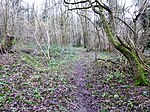Alkham
Civil parishes in KentKent geography stubsUse British English from February 2014Villages in Kent

Alkham is a village and civil parish in the Dover district of Kent, England, about five miles west of Dover. Within the parish are the settlements of Chalksole and Ewell Minnis; the parish population was 691 people (2001 census), reducing slightly to 688 at the 2011 Census.Alkham's Grade I listed Anglican church is dedicated to St Anthony. The former Wesleyan chapel on Slip Lane is now a private residence. The parishes of Alkham and River form the River ward in the Dover local government district.
Excerpt from the Wikipedia article Alkham (License: CC BY-SA 3.0, Authors, Images).Alkham
Alkham Valley Road,
Geographical coordinates (GPS) Address Nearby Places Show on map
Geographical coordinates (GPS)
| Latitude | Longitude |
|---|---|
| N 51.1347 ° | E 1.2211 ° |
Address
Newlyns Meadow
Alkham Valley Road
CT15 7DF
England, United Kingdom
Open on Google Maps









